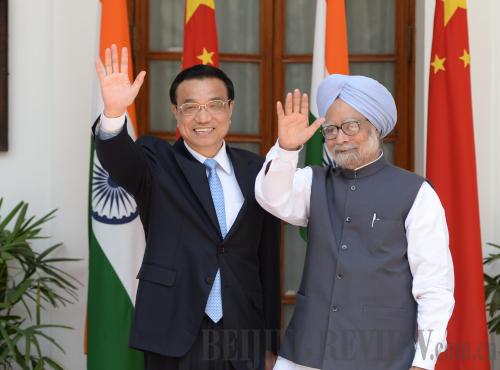|
 |
|
LOOKING AHEAD: Chinese Premier Li Keqiang meets with Indian Prime Minister Manmohan Singh in New Delhi on May 20 (MA ZHANCHENG) |
In an article published in two of India's most widely read newspapers, Dainik Jagran and The Hindu, on May 20 during his visit to India, Chinese Premier Li Keqiang likened the friendship between the two neighbors—China and India—as a handshake across the Himalayas. With the huge size of the world's two most populous nations, their "handshake" links more than one third of humanity.
Despite lingering disputes, observers say bilateral relations have seen remarkable progress in recent decades. Premier Li's visit to India, the opening leg of his maiden overseas trip since taking office, was welcomed by the Indian Government and public as a positive signal for further developing these ties. While Li noted in his speech at the Indian Council of World Affairs in New Delhi that some clouds in the sky cannot shield the sunshine of Sino-Indian friendship, observers pointed out that common interests and common goals for pursuing development would spur the two neighbors to seek cooperation while managing differences.
The big picture
"Premier Li's visit to India demonstrates both the high importance Beijing attaches to New Delhi and the confidence of the two sides for cooperation in regional and international affairs," said Sun Shihai, President of the Chinese Association for South Asian Studies. Sun added that the visit played a positive role in enhancing mutual trust.
Lou Chunhao, a researcher on South Asian studies with the China Institutes of Contemporary International Relations, told Beijing Review that as two emerging powers and the largest developing countries, both consider their relationship to be of special importance.
When meeting with Premier Li, Indian Prime Minister Manmohan Singh stressed that "India and China are partners, not opponents." Mainstream Indian media paid close attention to Li's visit. Press Trust of India wrote, "While President Xi Jinping chose to visit Russia on his way to the BRICS Summit in March, Li chose India to be his first destination abroad to send a message of the commitment of the new leadership to further friendly relations with New Delhi." The Times of India newspaper commented that it was a golden opportunity for New Delhi to seize and script a fresh, more positive chapter in bilateral relations.
A few days before Li's trip, a border standoff took place in the western part of the border the two countries share.
However, despite being much hyped by the international media, the incident was quickly resolved. Observers said it was a sign that the two neighbors are becoming more mature in handling their differences.
Chinese Vice Foreign Minister Song Tao said at a press conference before Li's trip that China and India should "focus on the big issues while managing properly the small issues."
Jiang Jingkui, Director of the Center of South Asian Studies at Peking University, said neither side is willing to allow a small issue like a border dispute to disrupt their strategic partnership.
During his stay in New Delhi, Premier Li said, "World peace and regional stability cannot be a reality without strategic mutual trust between China and India.
On the world stage, China and India are natural partners in reshaping global rules on climate change, trade and finance. They have already carried out effective cooperation within the frameworks of the Group of 20 and BRICS to push for a fairer multi-polar world.
Lou said the common ground of cooperation for both countries is the need for a peaceful and stable environment for development.
Business ties
During Li's trip to India, the two countries signed eight agreements in areas such as the economy, trade, agriculture and environmental protection to expand practical cooperation.
"Due to different development modes in the last decades, the two countries' economies are broadly complementary to each other. Thus, there is large space for economic cooperation," said Lou. "If the two big markets are well connected, they will give a strong impetus to the world economy."
China is strong in manufacturing and India excels in the IT industry, minerals, biomedicine, banking and outsourcing. China is now India's second largest trade partner, while India is China's biggest partner in South Asia. India's exports to China are mainly cotton and minerals, while China offers manufactured goods such as industrial equipment. Statistics from China's Ministry of Commerce show that two-way trade amounted to $66.5 billion last year, but both sides believe the potential is much greater. The two countries are aiming for a trade volume of $100 billion by 2015.
Sun said that to expand bilateral economic engagement, the huge potential of cooperation on Indian infrastructure construction and mutual investment must be further tapped.
| 